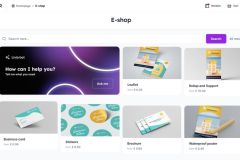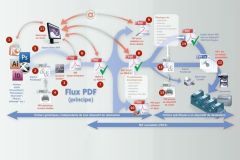We asked the question to the PrintFlux teams . With more than 200 operational systems in France and more than 18 years of experience, they have a very clear idea of the pitfalls to be avoided.
Error #1: Focusing on technology rather than customer needs.
Although the choice of a suitable technology is a key element in the implementation and development of e-commerce, it is crucial to give priority to the customer's objectives and needs. Once these are clearly defined, you can choose the technical solution and the human resources needed to implement the project - for example, choosing a Flash-based technology when all major accounts remove this technology from all their computers for security reasons is undoubtedly a strategic mistake.
Error #2: Wanting to reproduce the traditional commercial scheme in e-commerce.
Avoid trying to reproduce with e-commerce the same reflexes and processes as in traditional sales. We can see that over the Christmas period, consumer behavior changes, he abandons traditional shops to compare the offer on a multitude of e-commerce sites. This behaviour already extends to the professional market, of which printing is a part. The approach proposed by CAPM for the traditional market - one request, one quotation, one price - is undoubtedly unsuitable for the success of Web-to-Print.
Error #3: Not being proactive.
Avoid falling into the trap of simply responding to customer requests without looking further - for example, sending an e-invoice to a customer who has requested it without knowing whether other customers might also benefit. Preferably, explore new e-commerce technologies and deliberately offer them to each of your customers. You will then be seen as a knowledgeable and reliable partner that customers can rely on to stay competitive. This approach will also maximize your own return on investment.
Error #4: Not clearly defining a set of practices, an organizational infrastructure and a budget.
If your e-commerce experience is still in its infancy, it may be premature to develop a concrete approach to implementation. Nothing could be further from the truth. Establishing a clear set of technical parameters, operational and change management strategies at the outset will put you in a position to get the results you want. In addition to clearly defined procedures and processes, your plan should include specific information on the personnel, training and resources needed for seamless implementation, and support for customers after the go-live date. This platform can serve as a basis for your business development. It also serves as a framework within which you and your customers can work together while saving time and money.
Error #5: Developing only one aspect of e-commerce.
While it is tempting to focus on the online ordering process alone - the most attractive given its positive effect on sales - this neglect would cause you to miss out on the benefits of the other areas of e-commerce, namely production, invoicing and tracking of collections. By incorporating efficient production processes and higher customer satisfaction into your e-commerce strategy, you will be able to build a stronger and more efficient e-commerce offering that can be extremely advantageous.
Error #6: Not communicating with customers.
Some printers fall into the trap of implementing more unilaterally. This unilaterality could prevent you from knowing the customer's possible specific functional requirements, and you could find yourself in the position of having to rectify or stop work that is already well advanced - it is not up to the customer to adapt to the web-to-print solution, but up to the solution to integrate into the customer's organisation. By staying in close communication with your customers at every stage of implementation, you will be able to quickly and efficiently develop a suitable solution.
Error #7: Not taking a silo integration approach.
The various e-commerce platforms available in today's market give large accounts and printers myriad options. On the other hand, the integration of your business systems with different customers complicates the process. It is far preferable to use more flexible IT bridges that provide the necessary interpretation between your systems and those of your customers. This will make it easier for you to maintain costs and manage ongoing maintenance requirements while meeting specific customer needs.
Error #8: Do not remain pragmatic.
Establishing a clear approach to e-commerce is part of the set of best practices. However, be careful not to go too far and become too demanding in your processes, so as not to complicate the flow between your production and your customers. You must remain pragmatic about functionalities and not prolong integration unnecessarily.
Error #9: Lagging behind technology developments and capabilities.
If you do not keep up with the advances in e-commerce or the technical platform you have chosen does not allow it, your image could suffer, as you would appear at best unwise and at worst indifferent to the interests of your customers. Conversely, adopting new resources early and advocating them to customers can boost customer satisfaction and reap the benefits long before the competition does.
Error #10: Keeping your e-commerce experience a secret.
As e-commerce grows, the experience you gain with each integration becomes more and more valuable and will allow you to differentiate yourself. Make sure you capitalize on the knowledge and experience by promoting your e-commerce capabilities whenever and wherever possible.

























